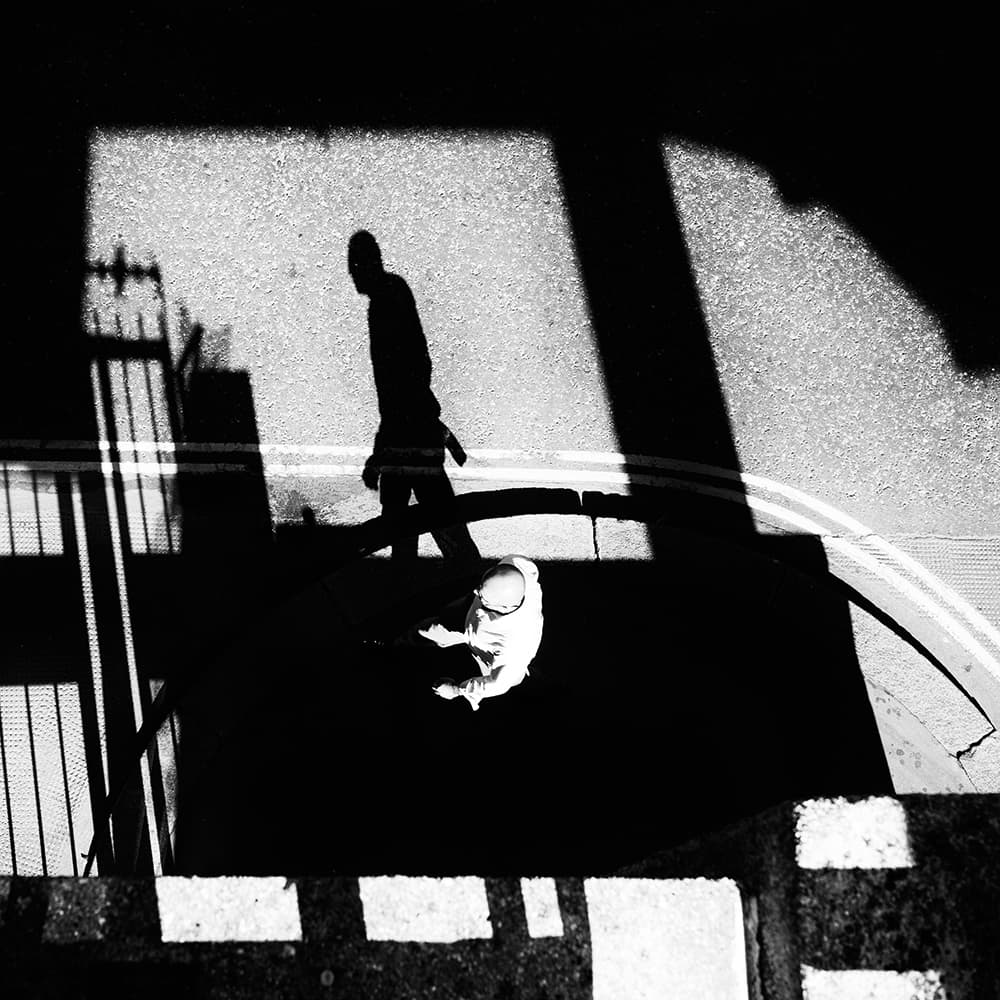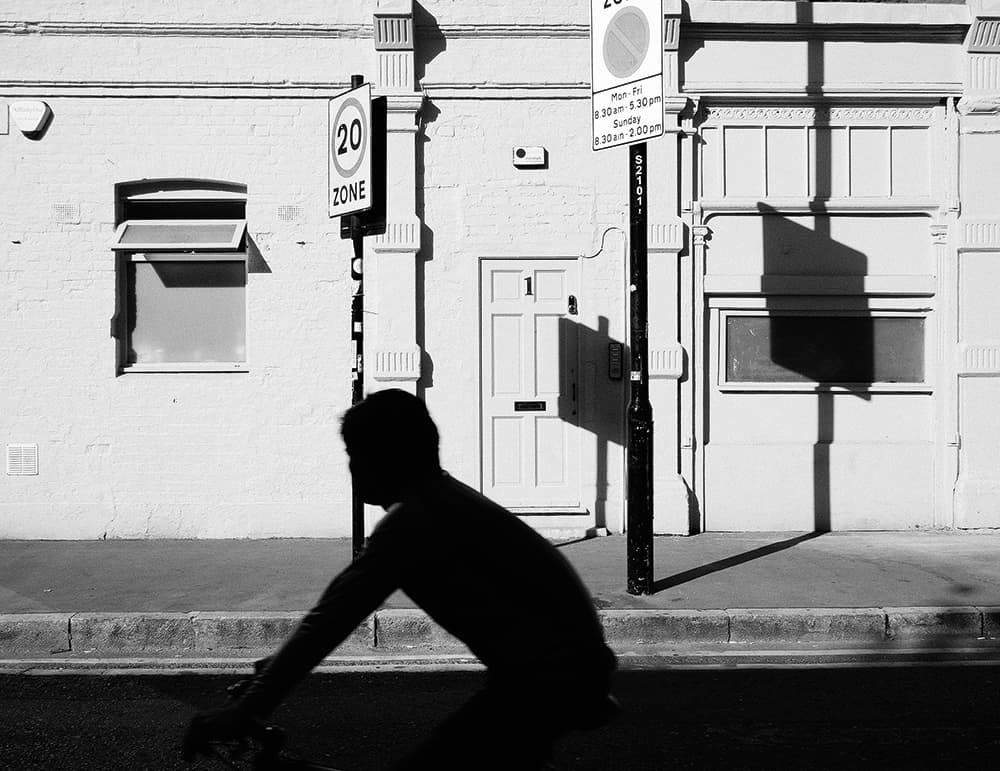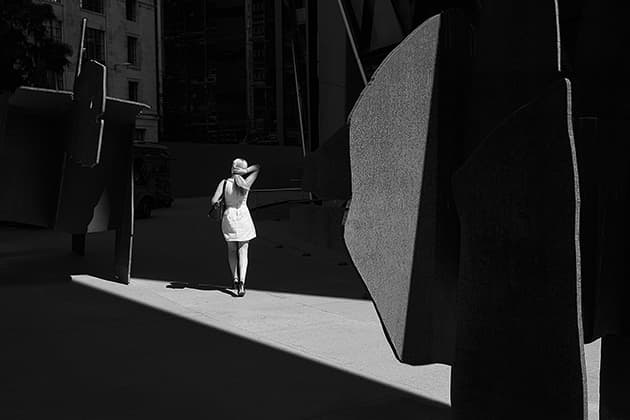After months of short winter days in which the low sun struggled to break through and the streets seemed to be forever in gloom, the early spring weather is a joy to behold. It’s my favourite time of year. As a photographer whose main hunting ground is deep within the metropolis, I can once again look forward to long days working with beautiful light that creates breathtaking scenes.
Shadows are full, and there is a good tonal range between them and the brilliant highlights. For those working in black & white, the vitality of the city is the perfect place to show the greyscale palette.
The weeks between late April and early June are the best. Around mid-May the light has a very special quality. In the mornings, until about 11.30am, it is clean and clear, and everything feels alive. The trees have yet to become lush with leaves. They let light through, creating intricate patterns on the ground. With a spring rain shower, the streets put on a dazzling show.

Unusual viewpoints can lend a scene a strangely abstract quality, particularly when combined with strong graphic elements and powerful light
The light
The afternoon light is more subtle, and has a real warmth and ambience to it. This is a good time to think more abstractly about your pictures. As the sun sinks, it catches people as they move around the streets, creating dramatic points of light and silhouettes. Backlighting is strong and long, and soft shadows are dominant. As the sun peeks through the architecture, its rays fall in patches creating a combination of shapes, forms and graphic activity, providing plenty of source material for your pictures.
I love images made up like this, especially when they strike a slightly discordant note. Fragments of objects and people are often more visually appealing than the whole, perhaps adding a sense of drama or intrigue. Don’t be afraid to experiment and to try new things. Move around an area to get a feel for how the elements best balance hemselves. What interesting zones are being created? Shadow areas will often be your foundations, but it’s important to place your lighter areas carefully so that they play a proper supporting role.
It’s also a great time of year for reflections. There is so much glass and steel in our cities providing a wealth of opportunities with light. Pedestrians merging in shop windows, buildings mirrored in car roofs and light patterns imprinted on roads are some of the things to look for, and further examples of how we can use spring’s vibrant light to our advantage.
Angles and highlights
I tend to expose for the highlights and often let the shadows fall dark, as I want to use them as graphically as possible. I use a small aperture for maximum depth of field and I’ll underexpose a little to create a more subdued mood in the late-afternoon sun. I’m particularly fond of geometric shapes created by shadows. Their tight angles and long lines can have an almost ‘cubist’ feel to them. For me, these are the building blocks and during spring’s sunny days they have a delicate, feathery edge which softens them just enough.
They’ll generally need to be balanced by a complementary lighter area. Depending on your scene, it can be anything from pure sunlight on a surface to the narrowest of white lines. Indeed, a thin line of light can be a winning feature. Whether it leads the eye into the frame or cuts through a heavily shadowed area, it can make the image really work.

Using Rupert’s methods, people become a graphic element within the overall scene
People
As the warmer weather arrives, people tend to shed their coats for lighter clothing. Their prominence on the street can be used to great effect. Shapes and colours can be used creatively to bring other areas of your scene to life. I have used many a white-clothed figure to add scale or drama to an image.
It’s quite important how you feature people in your frame, and their position in the scene can have different effects. Catching them in the right light is the trick. I usually want to be quite precise about this, because for me they aren’t just passing through, they are playing a key role and it is up to you to try to anticipate their movements. I also like how random figures move through shadows, occasionally catching a beam of light to create a kind of ‘mosaic’ effect. Whether in full light or partly exposed, it’s all about how they fit in the composition. The juxtaposition between the urban landscape and the human form is fascinating.
Street furniture
While the human element or the architecture may be the main focus of your pictures, the use of street furniture can also work as an interesting graphic element. It can be anything from benches, billboards and road markings to kerb sides or even drain covers. They can all add a focal point and help to balance a scene. I once became fascinated by the way a handrail was creating a shadow on the pavement, and how it wrapped itself over a step and lined up with the cracks in the pavement. When a woman in heels walked by, it completed the scene.
Another time, strong lines of shadow were cast as the sun hit the railings of a bridge. Below, a man stood looking at the sky, perfectly framed between them. These are some of the moments I’ll look out for in the bright spring light.

Rather than focusing just on people, Rupert also finds the time to capture the ‘street furniture’ as well
Born and based in London, Rupert Vandervell’s photographic style is representative of his personality. He’s always been obsessed with clean lines, and his work explores how we interact with our environment. Visit www.rupertvandervell.co.uk








